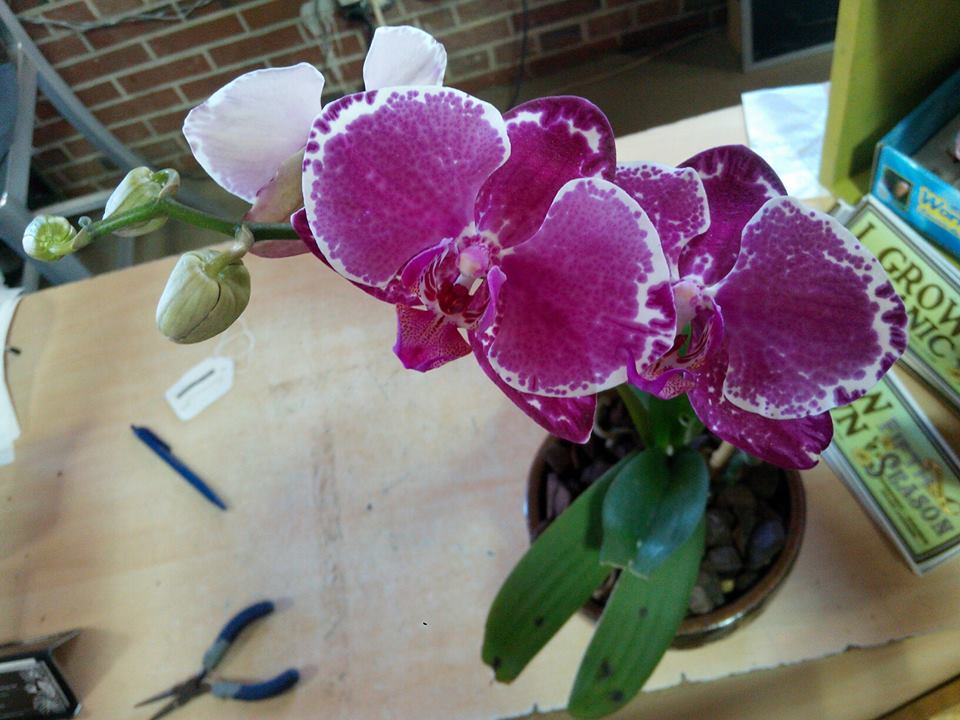 Orchids tend to elicit a strong emotion from people: most of us love looking at them, but too many folks cringe at the thought of caring for them. Honestly, their care is way easier than most people think, as they have evolved to need a fair amount of benign neglect. Those that tend to kill them most handily, ironically, tend to over care for their plants. In my opinion, it is better to primarily focus on the basic soil, light, and nutrient needs. While it is the easiest way to kill an orchid, watering is a concern that should come up last. I should mention, in this post I will focus mostly on the Phalaenopsis as it is the variety we most often carry at Fifth Season Gardening and the most common variety found in retail stores. For other varieties, you can find endless amounts of information online, and apply some of the basic skills in this post.
Orchids tend to elicit a strong emotion from people: most of us love looking at them, but too many folks cringe at the thought of caring for them. Honestly, their care is way easier than most people think, as they have evolved to need a fair amount of benign neglect. Those that tend to kill them most handily, ironically, tend to over care for their plants. In my opinion, it is better to primarily focus on the basic soil, light, and nutrient needs. While it is the easiest way to kill an orchid, watering is a concern that should come up last. I should mention, in this post I will focus mostly on the Phalaenopsis as it is the variety we most often carry at Fifth Season Gardening and the most common variety found in retail stores. For other varieties, you can find endless amounts of information online, and apply some of the basic skills in this post.
Since Phalaenopsis Orchids are naturally epiphytic, meaning they grow on other plants, they have adapted to need plenty of airflow to their roots. As such, they need specific types of soil and prefer pots with extra airflow. Their soil can either be a blend of bark, or long fiber sphagnum moss. We carry an amazing brand of orchid bark, Orchiata, which has been adopted by orchid aficionados around the world. With bark, orchids will need to be watered more frequently than moss, but tend to be easier to not over-water. So if you have a history of over-watering your orchids, bark is the way to go.
Orchid pots can be decorative or plain, but all have one thing in common: plenty of holes in the sides to promote airflow. I have recently had a lot of success with our net cups. As far as when to repot an orchid, generally it is recommended not to repot an orchid while it is blooming. I have personally done exactly that many times, especially if the plant comes in tightly packed moss, but again, most folks recommended waiting until the flowering has finished.
Placing Orchids within our homes can be tricky given furniture and window constraints, but finding the best spot for them will help produce the most beautiful returns. As far as light requirements go, Orchids need very bright, preferably indirect light. The best I have ever personally done was by placing my phalaenopsis directly to the left of an unobstructed second-story south facing window. Consider that the most ideal location, followed by sitting in either an east or west window. If those windows face slightly south and get the mid-day sun, you will want to move the plants toward the side of the window. You can also keep orchids outside in the summer, but be sure to keep them out of direct sunlight, especially during the mid-day.
There are a myriad of options when picking nutrients for your orchid. I will recommend a couple of nutrients that have yielded the best success for many of our customers. First, Kelp. Kelp is something that I cannot mention enough. My best reason for using it with orchids is that it acts to minimize stress. With Orchids, that means bigger flower stalks, more flowers, and potentially more frequent flowering. My experience with this has been anecdotal, but reliable and reproduced by our customers. The other nutrient that I like to suggest is the Dyna-Gro Grow formula. It will promote flowering, even though it is a vegetative formula. I use the two together and feed about every couple weeks at half the strength listed on the bottles.
Lastly, but certainly most importantly, good watering habits are key to successfully growing orchids. Most importantly, remember that the Phalaenopsis likes a fair amount benign neglect. Typically, they should be watered no more than once per week, and often less than that. Now, many people have heard of the ice cube method for watering, and I cringe everytime someone asks me about it. I have heard time and time again that it works for people, but these little tropicals have not evolved to interact with ice. I typically recommend letting an ice cube or two melt in a glass. When that glass comes to room temperature, that is a great amount to water your orchids. I have heard that, if the orchid is in bark and there is space to put the ice cube, that doesn’t touch a root, the ice cube can be more readily absorbed by the bark. You could also mist the bark a little before watering, and find a similar result. Also, keep in mind that plants in long fiber moss will need to be watered less often than those in bark, and need less per watering.
I hope this helps you find a bit extra success while keeping orchids, and gives you a little urge to try the next one you find in the store.

Leave a Reply